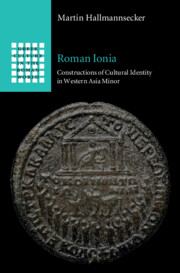Book contents
- Roman Ionia
- Greek Culture in the Roman World
- Roman Ionia
- Copyright page
- Dedication
- Contents
- List of Figures
- List of Maps
- List of Tables
- Acknowledgements
- List of Abbreviations
- Introduction
- Chapter 1 Mental Geographies
- Chapter 2 The Ionian Koinon
- Chapter 3 Cults and Myths
- Chapter 4 Times and Names
- Chapter 5 The Ionic Dialect
- Chapter 6 Ionianness outside Ionia
- Concluding Remarks
- Appendix: Evidence for Officials of the Ionian Koinon in the Roman Period
- Maps
- Bibliography
- Index of Ancient Sources
- General Index
Chapter 6 - Ionianness outside Ionia
Published online by Cambridge University Press: 05 May 2022
- Roman Ionia
- Greek Culture in the Roman World
- Roman Ionia
- Copyright page
- Dedication
- Contents
- List of Figures
- List of Maps
- List of Tables
- Acknowledgements
- List of Abbreviations
- Introduction
- Chapter 1 Mental Geographies
- Chapter 2 The Ionian Koinon
- Chapter 3 Cults and Myths
- Chapter 4 Times and Names
- Chapter 5 The Ionic Dialect
- Chapter 6 Ionianness outside Ionia
- Concluding Remarks
- Appendix: Evidence for Officials of the Ionian Koinon in the Roman Period
- Maps
- Bibliography
- Index of Ancient Sources
- General Index
Summary
That Ionianness was used as a form of cultural capital also outside of Ionia is demonstrated in the sixth chapter which turns attention to the littorals of the Black Sea, where a number of colonies from the Ionian cities founded in Archaic times cultivated their distinct cultural identities even in the Roman period. Further, the cities of Isinda in Pisidia and Synnada in Phrygia started to call themselves Ionians on their civic coins from the 2nd c. AD on. These examples of mythological kinship affiliations demonstrate that Ionianness remained a valid cultural resource in the Roman Imperial period employed to bestow prestige on cities in the competitive environment of the Roman provinces.
- Type
- Chapter
- Information
- Roman IoniaConstructions of Cultural Identity in Western Asia Minor, pp. 200 - 230Publisher: Cambridge University PressPrint publication year: 2022

